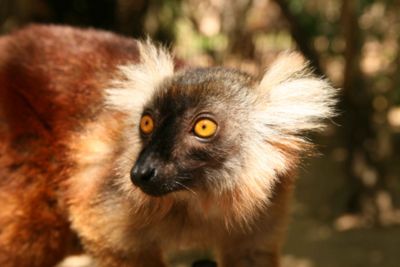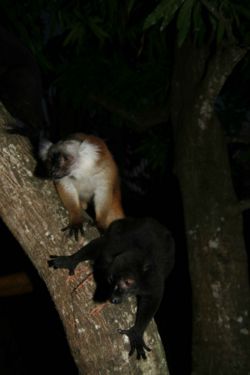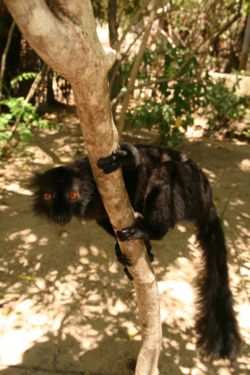Eulemur macaco (Black Lemur): Difference between revisions
imported>Chris Day (no need for cats) |
imported>Caesar Schinas m (Bot: Update image code) |
||
| (6 intermediate revisions by 5 users not shown) | |||
| Line 1: | Line 1: | ||
{{ | {{subpages}} | ||
{{Image|blemur female.jpg|right|400px|A female '''black lemur''', (''Eulemur macaco macaco'').}} | |||
The '''black lemur''' ''Eulemur macaco macaco'', a so called "true lemur", is a medium-sized quadrupedal [[Lemur]]. In the wild, it is found only on the island of [[Madagascar]]. | The '''black lemur''' ''Eulemur macaco macaco'', a so called "true lemur", is a medium-sized quadrupedal [[Lemur]]. In the wild, it is found only on the island of [[Madagascar]] and small islands of the Northeast coast. | ||
==Description== | ==Description== | ||
The black lemur is a cathemeral [[Primate]] that has a head body length of approximately 39 – 45 cm and a tail length of around 50-65 cm<ref name="Fleagle">{{cite book|title=Primate Adaptation and Evolution|accessdate=|author=J. Fleagle|authorlink= |coauthors= |date=1998 |format= |work= |publisher=Academic Press: New York|pages= |language= |archiveurl= |archivedate= |quote= }}</ref><ref name="Szalay">{{cite book |title=Evolutionary History of the Primates|accessdate=|author=F. Szalay and E. Delson|authorlink= |coauthors= |date=2001 |format= |work= |publisher=Academic Press, New York|pages= |language= |archiveurl= |archivedate= |quote= }}</ref><ref name="Mittermeier">{{cite book|title=Lemurs of Madagascar|accessdate=|author=Mittermeier et al.|authorlink= |coauthors= |date=2006 |format= |work= |publisher=Conservation International|pages= |language= |archiveurl= |archivedate= |quote= }}</ref>. Weight ranges between approximately 3 and 3.5 kg<ref name= "Mittermeier"/>. Males are typically dark chocolate brown to black, while females have golden-brown to chesnut colored backs and light colored bellies. The female's face is grey to black, the crown a darker grey and the ears white tuffed <ref name= "Mittermeier"/>. The eyes of both sexes are orange <ref name= "Mittermeier"/>. | The black lemur is a cathemeral [[Primate]] that has a head body length of approximately 39 – 45 cm and a tail length of around 50-65 cm<ref name="Fleagle">{{cite book|title=Primate Adaptation and Evolution|accessdate=|author=J. Fleagle|authorlink= |coauthors= |date=1998 |format= |work= |publisher=Academic Press: New York|pages= |language= |archiveurl= |archivedate= |quote= }}</ref><ref name="Szalay">{{cite book |title=Evolutionary History of the Primates|accessdate=|author=F. Szalay and E. Delson|authorlink= |coauthors= |date=2001 |format= |work= |publisher=Academic Press, New York|pages= |language= |archiveurl= |archivedate= |quote= }}</ref><ref name="Mittermeier">{{cite book|title=Lemurs of Madagascar|accessdate=|author=Mittermeier et al.|authorlink= |coauthors= |date=2006 |format= |work= |publisher=Conservation International|pages= |language= |archiveurl= |archivedate= |quote= }}</ref>. Weight ranges between approximately 3 and 3.5 kg<ref name= "Mittermeier"/>. Males are typically dark chocolate brown to black, while females have golden-brown to chesnut colored backs and light colored bellies. The female's face is grey to black, the crown a darker grey and the ears white tuffed <ref name= "Mittermeier"/>. The eyes of both sexes are orange <ref name= "Mittermeier"/>. | ||
{{Image|black lemurs.jpg|left|250px|A male and female black lemur at night. Black lemurs are cathemeral and are highly active in both the day and night}} | |||
==Behaviour== | ==Behaviour== | ||
The black lemur is highly adaptable to different habitats and group sizes range from 2 to 15 <ref name= "Mittermeier"/>. Females give birth to typically a single young usually between September and November<ref name= "Mittermeier"/>. | The black lemur is highly adaptable to different habitats and group sizes range from 2 to 15 <ref name= "Mittermeier"/>. Females give birth to typically a single young usually between September and November<ref name= "Mittermeier"/>. | ||
{{Image|blemur male.jpg|right|250px|A male black lemur climbing. }} | |||
==Diet== | ==Diet== | ||
| Line 25: | Line 25: | ||
The black lemur is considered to be endangered by the IUCN. | The black lemur is considered to be endangered by the IUCN. | ||
==References== | ==References== | ||
{{reflist}} | {{reflist}} | ||
Revision as of 04:28, 8 June 2009
The black lemur Eulemur macaco macaco, a so called "true lemur", is a medium-sized quadrupedal Lemur. In the wild, it is found only on the island of Madagascar and small islands of the Northeast coast.
Description
The black lemur is a cathemeral Primate that has a head body length of approximately 39 – 45 cm and a tail length of around 50-65 cm[1][2][3]. Weight ranges between approximately 3 and 3.5 kg[3]. Males are typically dark chocolate brown to black, while females have golden-brown to chesnut colored backs and light colored bellies. The female's face is grey to black, the crown a darker grey and the ears white tuffed [3]. The eyes of both sexes are orange [3].
Behaviour
The black lemur is highly adaptable to different habitats and group sizes range from 2 to 15 [3]. Females give birth to typically a single young usually between September and November[3].
Diet
It is highly frugiverous but also eats seeds, leaves and nectar [2][3].
Geographical distribution
The black lemur may be found in tropical moist lowland and montane forested areas of northwestern Madagascar and on islands around Nosy Be[3].
Status
The black lemur is considered to be endangered by the IUCN.


